2019 KIA SPORTAGE air conditioning
[x] Cancel search: air conditioningPage 413 of 607
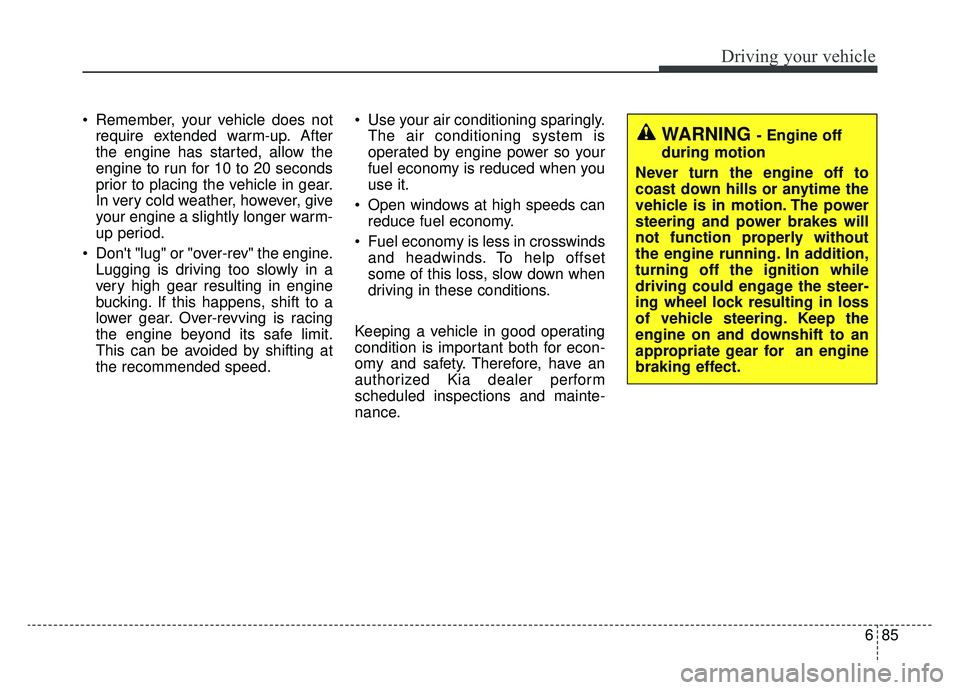
685
Driving your vehicle
Remember, your vehicle does notrequire extended warm-up. After
the engine has started, allow the
engine to run for 10 to 20 seconds
prior to placing the vehicle in gear.
In very cold weather, however, give
your engine a slightly longer warm-
up period.
Don't "lug" or "over-rev" the engine. Lugging is driving too slowly in a
very high gear resulting in engine
bucking. If this happens, shift to a
lower gear. Over-revving is racing
the engine beyond its safe limit.
This can be avoided by shifting at
the recommended speed. Use your air conditioning sparingly.
The air conditioning system is
operated by engine power so your
fuel economy is reduced when you
use it.
Open windows at high speeds can reduce fuel economy.
Fuel economy is less in crosswinds and headwinds. To help offset
some of this loss, slow down when
driving in these conditions.
Keeping a vehicle in good operating
condition is important both for econ-
omy and safety. Therefore, have an
authorized Kia dealer perform
scheduled inspections and mainte-
nance.
WARNING - Engine off
during motion
Never turn the engine off to
coast down hills or anytime the
vehicle is in motion. The power
steering and power brakes will
not function properly without
the engine running. In addition,
turning off the ignition while
driving could engage the steer-
ing wheel lock resulting in loss
of vehicle steering. Keep the
engine on and downshift to an
appropriate gear for an engine
braking effect.
Page 479 of 607

Maintenance
68
OWNER MAINTENANCE
The following lists are vehicle checks
and inspections that should be per-
formed by the owner or an author-
ized Kia dealer at the frequencies
indicated to help ensure safe,
dependable operation of your vehi-
cle.
Any adverse conditions should be
brought to the attention of your deal-
er as soon as possible.
These Owner Maintenance Checks
are generally not covered by war-
ranties and you may be charged for
labor, parts and lubricants used.Owner maintenance schedule
When you stop for fuel:
Check the engine oil level.
Check the coolant level in thecoolant reservoir.
Check the windshield washer fluid level.
Look for low or under-inflated tires.
While operating your vehicle:
Note any changes in the sound of the exhaust or any smell of
exhaust fumes in the vehicle.
Check for vibrations in the steering wheel. Notice any increased steer-
ing effort or looseness in the steer-
ing wheel, or change in its straight-
ahead position.
Notice if your vehicle constantly turns slightly or “pulls” to one side
when traveling on smooth, level
roads.
When stopping, listen and check for unusual sounds, pulling to one
side, increased brake pedal travel
or “hard-to-push” brake pedal.
If any slipping or changes in the operation of your transaxle occurs,
check the transaxle fluid level.
Check the automatic transaxle P (Park) function.
Check the parking brake.
Check for fluid leaks under your vehicle (water dripping from the air
conditioning system during or after
use is normal).
WARNING - Hot coolant
Be careful when checking your
engine coolant level when the
engine is hot. Scalding hot
coolant and steam may blow
out under pressure.
Page 480 of 607
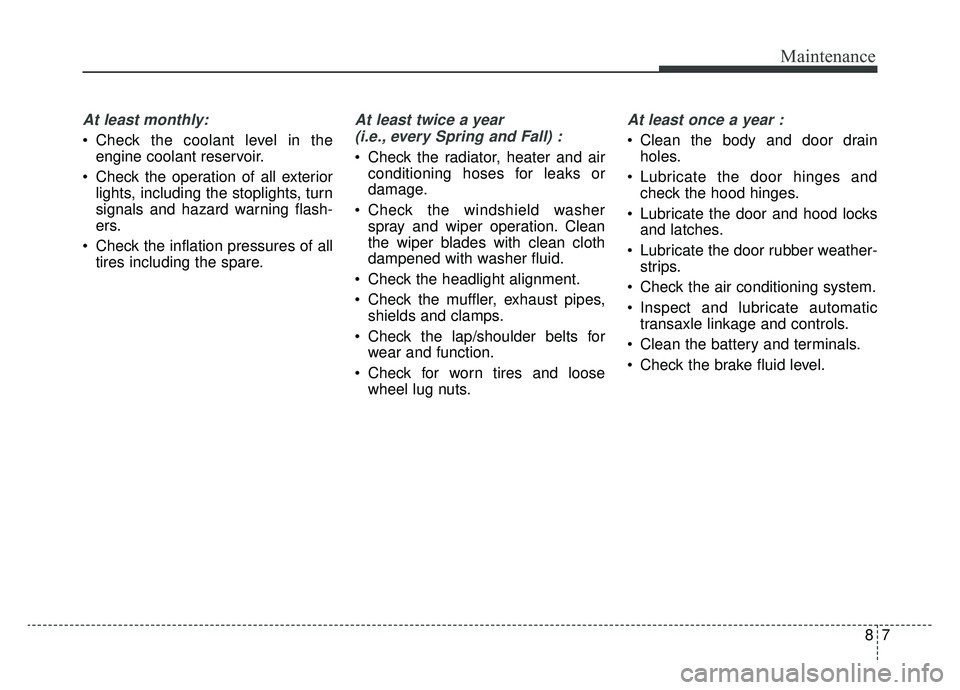
87
Maintenance
At least monthly:
Check the coolant level in theengine coolant reservoir.
Check the operation of all exterior lights, including the stoplights, turn
signals and hazard warning flash-
ers.
Check the inflation pressures of all tires including the spare.
At least twice a year
(i.e., every Spring and Fall) :
Check the radiator, heater and air conditioning hoses for leaks or
damage.
Check the windshield washer spray and wiper operation. Clean
the wiper blades with clean cloth
dampened with washer fluid.
Check the headlight alignment.
Check the muffler, exhaust pipes, shields and clamps.
Check the lap/shoulder belts for wear and function.
Check for worn tires and loose wheel lug nuts.
At least once a year :
Clean the body and door drainholes.
Lubricate the door hinges and check the hood hinges.
Lubricate the door and hood locks and latches.
Lubricate the door rubber weather- strips.
Check the air conditioning system.
Inspect and lubricate automatic transaxle linkage and controls.
Clean the battery and terminals.
Check the brake fluid level.
Page 496 of 607
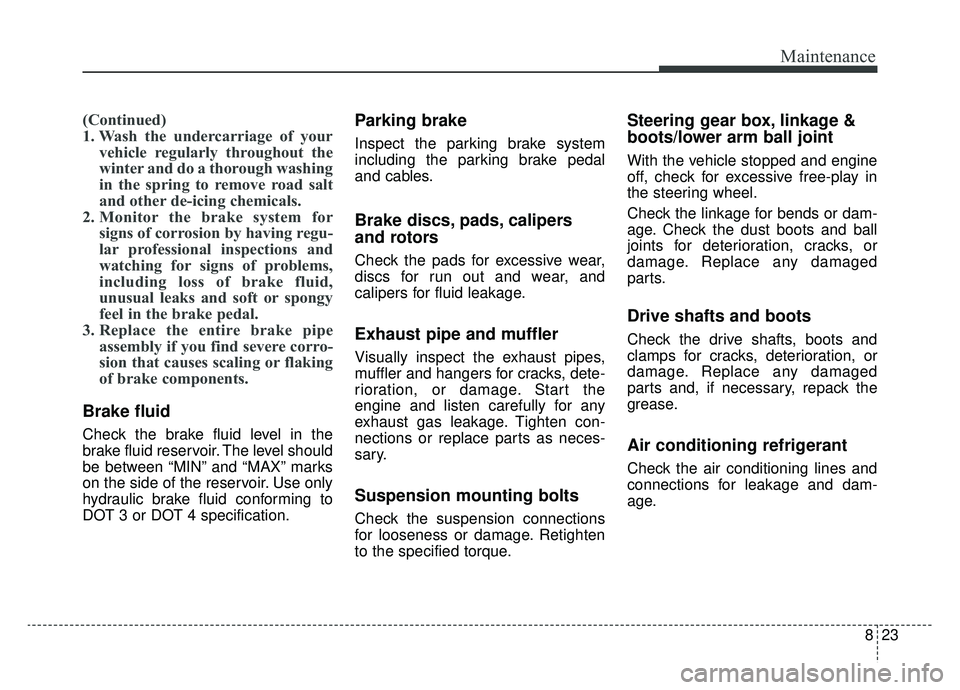
823
Maintenance
(Continued)
1. Wash the undercarriage of yourvehicle regularly throughout the
winter and do a thorough washing
in the spring to remove road salt
and other de-icing chemicals.
2. Monitor the brake system for signs of corrosion by having regu-
lar professional inspections and
watching for signs of problems,
including loss of brake fluid,
unusual leaks and soft or spongy
feel in the brake pedal.
3. Replace the entire brake pipe assembly if you find severe corro-
sion that causes scaling or flaking
of brake components.
Brake fluid
Check the brake fluid level in the
brake fluid reservoir. The level should
be between “MIN” and “MAX” marks
on the side of the reservoir. Use only
hydraulic brake fluid conforming to
DOT 3 or DOT 4 specification.
Parking brake
Inspect the parking brake system
including the parking brake pedal
and cables.
Brake discs, pads, calipers
and rotors
Check the pads for excessive wear,
discs for run out and wear, and
calipers for fluid leakage.
Exhaust pipe and muffler
Visually inspect the exhaust pipes,
muffler and hangers for cracks, dete-
rioration, or damage. Start the
engine and listen carefully for any
exhaust gas leakage. Tighten con-
nections or replace parts as neces-
sary.
Suspension mounting bolts
Check the suspension connections
for looseness or damage. Retighten
to the specified torque.
Steering gear box, linkage &
boots/lower arm ball joint
With the vehicle stopped and engine
off, check for excessive free-play in
the steering wheel.
Check the linkage for bends or dam-
age. Check the dust boots and ball
joints for deterioration, cracks, or
damage. Replace any damaged
parts.
Drive shafts and boots
Check the drive shafts, boots and
clamps for cracks, deterioration, or
damage. Replace any damaged
parts and, if necessary, repack the
grease.
Air conditioning refrigerant
Check the air conditioning lines and
connections for leakage and dam-
age.
Page 577 of 607
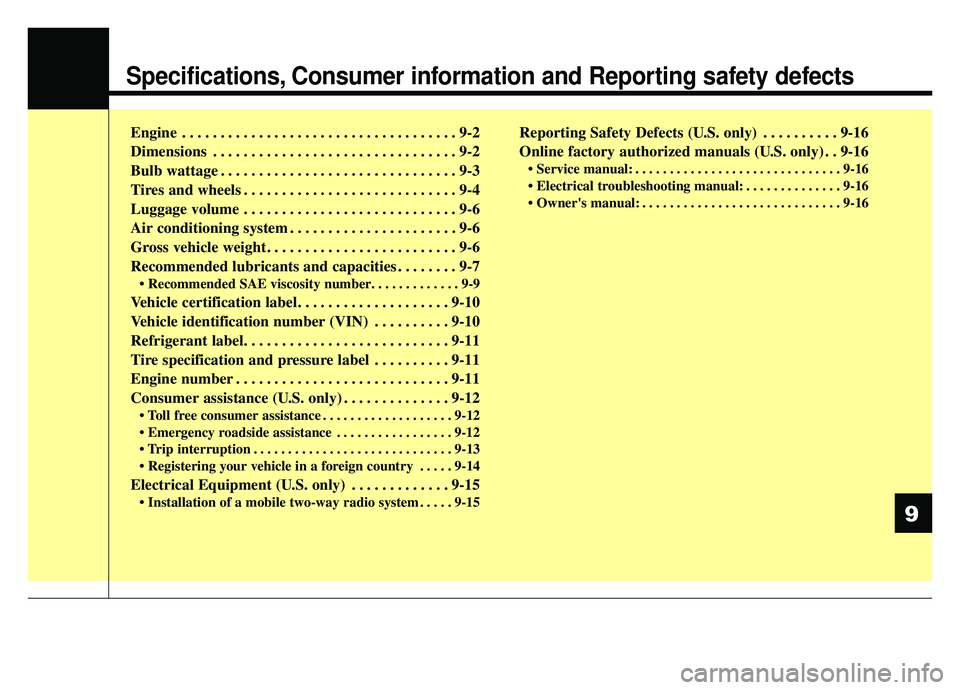
Specifications, Consumer information and Reporting safety defects
Engine . . . . . . . . . . . . . . . . . . . . . . . . . . . . . . . . . . . . \
9-2
Dimensions . . . . . . . . . . . . . . . . . . . . . . . . . . . . . . . . 9-2
Bulb wattage . . . . . . . . . . . . . . . . . . . . . . . . . . . . . . . 9-3
Tires and wheels . . . . . . . . . . . . . . . . . . . . . . . . . . . . 9-4
Luggage volume . . . . . . . . . . . . . . . . . . . . . . . . . . . . 9-6
Air conditioning system . . . . . . . . . . . . . . . . . . . . . . 9-6
Gross vehicle weight. . . . . . . . . . . . . . . . . . . . . . . . . 9-6
Recommended lubricants and capacities . . . . . . . . 9-7
• Recommended SAE viscosity number. . . . . . . . . . . . . 9-9
Vehicle certification label. . . . . . . . . . . . . . . . . . . . 9-10
Vehicle identification number (VIN) . . . . . . . . . . 9-10
Refrigerant label. . . . . . . . . . . . . . . . . . . . . . . . . . . 9-11
Tire specification and pressure label . . . . . . . . . . 9-11
Engine number . . . . . . . . . . . . . . . . . . . . . . . . . . . . 9-11
Consumer assistance (U.S. only) . . . . . . . . . . . . . . 9-12
. . . . . . . . . . . . . . . . . . . 9-12
. . . . . . . . . . . . . . . . . 9-12
. . . . . . . . . . . . . . . . . . . . . . . . . . . . . 9-13
. . . . . 9-14
Electrical Equipment (U.S. only) . . . . . . . . . . . . . 9-15
. . . . . 9-15
Reporting Safety Defects (U.S. only) . . . . . . . . . . 9-16
Online factory authorized manuals (U.S. only) . . 9-16
. . . . . . . . . . . . . . . . . . . . . . . . . . . . . . 9-16
. . . . . . . . . . . . . . 9-16
. . . . . . . . . . . . . . . . . . . . . . . . . . . . . 9-16
9
Page 582 of 607
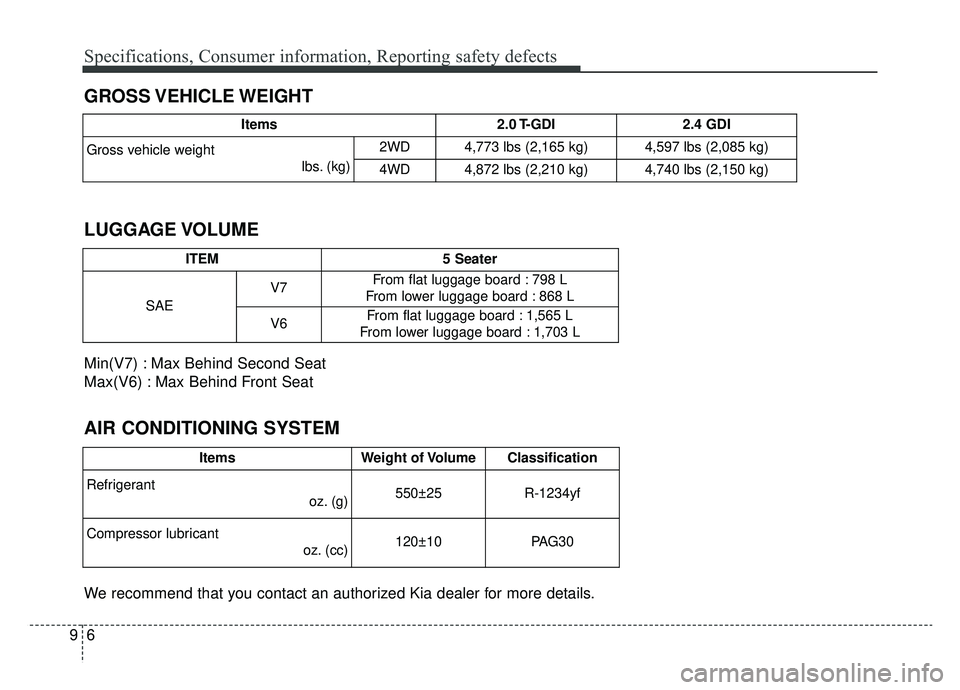
Specifications, Consumer information, Reporting safety defects
69
GROSS VEHICLE WEIGHT
AIR CONDITIONING SYSTEM LUGGAGE VOLUME
We recommend that you contact an authorized Kia dealer for more details. Min(V7) : Max Behind Second Seat
Max(V6) : Max Behind Front Seat
Items2.0 T-GDI2.4 GDI
Gross vehicle weightlbs. (kg)2WD4,773 lbs (2,165 kg)4,597 lbs (2,085 kg)
4WD4,872 lbs (2,210 kg)4,740 lbs (2,150 kg)
ITEM5 Seater
SAE
V7From flat luggage board : 798 L
From lower luggage board : 868 L
V6From flat luggage board : 1,565 L
From lower luggage board : 1,703 L
ItemsWeight of VolumeClassification
Refrigerant oz. (g)550±25R-1234yf
Compressor lubricantoz. (cc) 120±10PAG30
Page 594 of 607
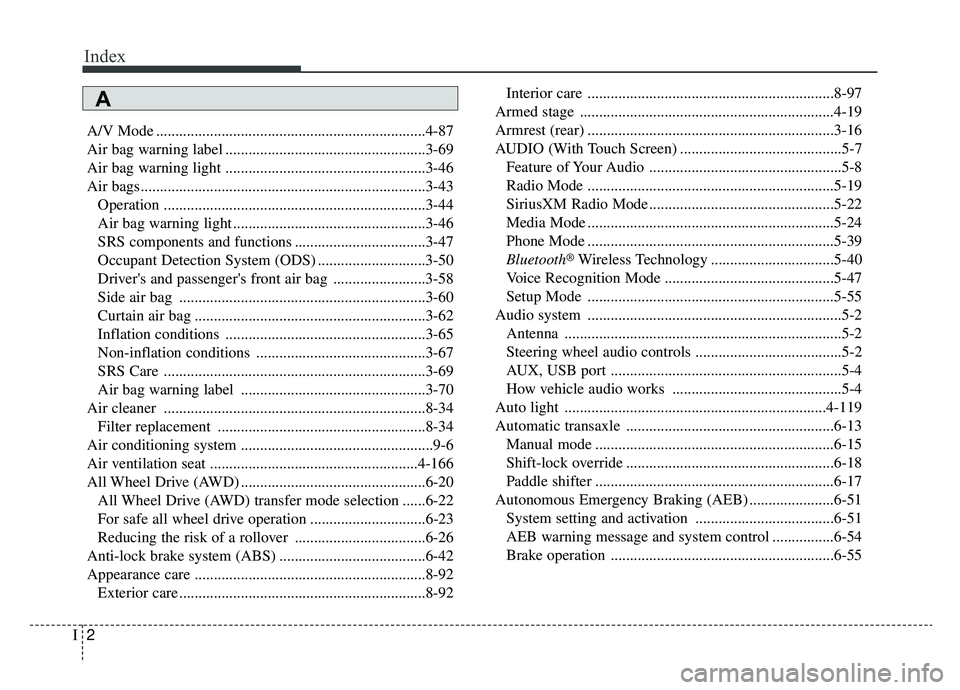
Index
2I
A/V Mode ......................................................................4-\
87
Air bag warning label ....................................................3-69
Air bag warning light ....................................................3-46
Air bags........................................................................\
..3-43Operation ....................................................................3-44\
Air bag warning light ..................................................3-46
SRS components and functions ..................................3-47
Occupant Detection System (ODS) ............................3-50
Driver's and passenger's front air bag ........................3-58
Side air bag ................................................................3-60
Curtain air bag ............................................................3-62
Inflation conditions ....................................................3-65
Non-inflation conditions ............................................3-67
SRS Care ....................................................................3-69\
Air bag warning label ................................................3-70
Air cleaner ....................................................................8-34\
Filter replacement ......................................................8-34
Air conditioning system ..................................................9-6
Air ventilation seat ......................................................4-166
All Wheel Drive (AWD) ................................................6-20 All Wheel Drive (AWD) transfer mode selection ......6-22
For safe all wheel drive operation ..............................6-23
Reducing the risk of a rollover ..................................6-26
Anti-lock brake system (ABS) ......................................6-42
Appearance care ............................................................8-92 Exterior care ................................................................8-92 Interior care ................................................................8-97
Armed stage ..................................................................4-19
Armrest (rear) ................................................................3-16
AUDIO (With Touch Screen) ..........................................5-7 Feature of Your Audio ..................................................5-8
Radio Mode ................................................................5-19
SiriusXM Radio Mode ................................................5-22
Media Mode ................................................................5-24
Phone Mode ................................................................5-39
Bluetooth
®Wireless Technology ................................5-40
Voice Recognition Mode ............................................5-47
Setup Mode ................................................................5-55
Audio system ..................................................................5-2 Antenna ........................................................................\
5-2
Steering wheel audio controls ......................................5-2
AUX, USB port ............................................................5-4
How vehicle audio works ............................................5-4
Auto light ....................................................................4-11\
9
Automatic transaxle ......................................................6-13 Manual mode ..............................................................6-15
Shift-lock override ......................................................6-18
Paddle shifter ..............................................................6-17
Autonomous Emergency Braking (AEB) ......................6-51 System setting and activation ....................................6-51
AEB warning message and system control ................6-54
Brake operation ..........................................................6-55
A
Page 596 of 607
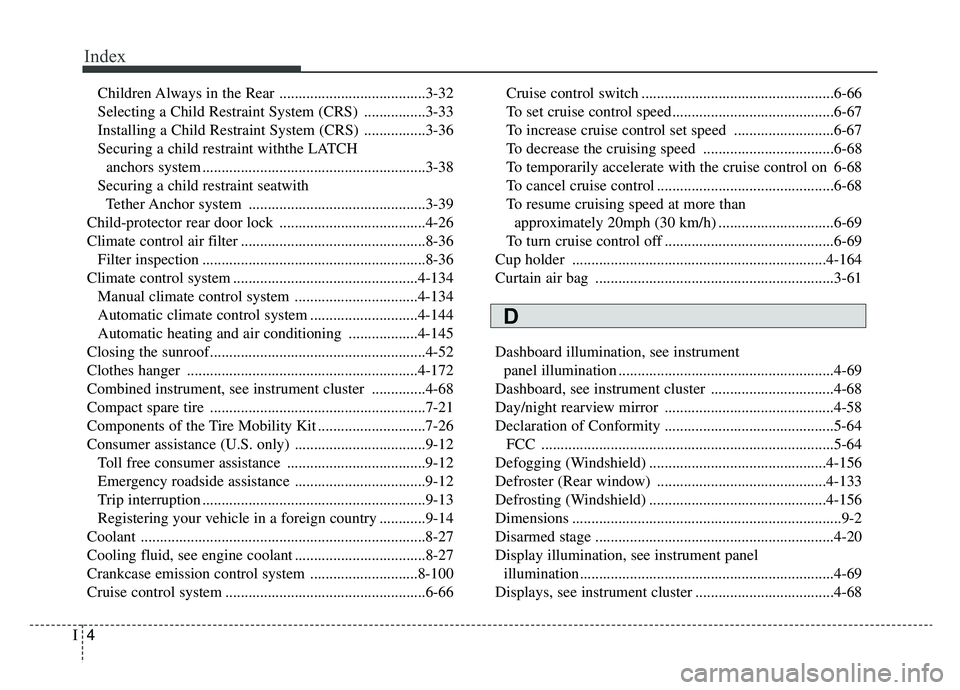
Index
4I
Children Always in the Rear ......................................3-32
Selecting a Child Restraint System (CRS) ................3-33
Installing a Child Restraint System (CRS) ................3-36
Securing a child restraint withthe LATCH anchors system ..........................................................3-38
Securing a child restraint seatwith Tether Anchor system ..............................................3-39
Child-protector rear door lock ......................................4-26
Climate control air filter ................................................8-36 Filter inspection ..........................................................8-36
Climate control system ................................................4-134 Manual climate control system ................................4-134
Automatic climate control system ............................4-144
Automatic heating and air conditioning ..................4-145
Closing the sunroof........................................................4-52
Clothes hanger ............................................................4-172
Combined instrument, see instrument cluster ..............4-68
Compact spare tire ........................................................7-21
Components of the Tire Mobility Kit ............................7-26
Consumer assistance (U.S. only) ..................................9-12 Toll free consumer assistance ....................................9-12
Emergency roadside assistance ..................................9-12
Trip interruption ..........................................................9-13
Registering your vehicle in a foreign country ............9-14
Coolant ........................................................................\
..8-27
Cooling fluid, see engine coolant ..................................8-27
Crankcase emission control system ............................8-100
Cruise control system ....................................................6-66 Cruise control switch ..................................................6-66
To set cruise control speed..........................................6-67
To increase cruise control set speed ..........................6-67
To decrease the cruising speed ..................................6-68
To temporarily accelerate with the cruise control on 6-68
To cancel cruise control ..............................................6-68
To resume cruising speed at more than approximately 20mph (30 km/h) ..............................6-69
To turn cruise control off ............................................6-69
Cup holder ..................................................................4-164
Curtain air bag ..............................................................3-61
Dashboard illumination, see instrument panel illumination ........................................................4-69
Dashboard, see instrument cluster ................................4-68
Day/night rearview mirror ............................................4-58
Declaration of Conformity ............................................5-64 FCC ........................................................................\
....5-64
Defogging (Windshield) ..............................................4-156
Defroster (Rear window) ............................................4-133
Defrosting (Windshield) ..............................................4-156
Dimensions ......................................................................9-\
2
Disarmed stage ..............................................................4-20
Display illumination, see instrument panel illumination..................................................................4-69
Displays, see instrument cluster ....................................4-68
D